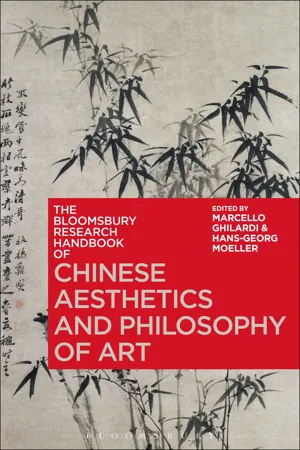![]()
PART ONE
Aesthetic Theories
![]()
Editors’ Introduction to Part One
MARCELLO GHILARDI
This section contains four contributions, which aim to illuminate some basic questions of Chinese aesthetics by going back to the theoretical frameworks that organize Chinese thought as a whole. In the first chapter, Wang Keping outlines a general introduction to Chinese aesthetics by crossing the main philosophical-religious currents of China, thus highlighting the strong ties that the artistic experience has bound with the whole of the cultural heritage. Confucianism, Daoism, Mohism, and Buddhism are the particular traditions that innervate the arts and constitute a common thread between the artistic practice and the constitution of society. It is possible to trace these developments up to the contemporary age, which is indebted in several ways to the Western conceptual apparatus. Moving from this problematic horizon, Ye Lang points out the identification of some difficulties he already found when he tried to define some basic lines of Chinese aesthetics in order to account for it in its breadth and complexity. In his chapter the intercultural dialogue is made explicit and builds a network of connections to follow between Western categories and Chinese characteristics, and he describes and understands the role and the importance of the arts and aesthetic reflection in the Chinese world, especially during the transition to modernity. The contributions of the two authoritative Western scholars who have signed the third and fourth chapters, Roger T. Ames and Karl-Heinz Pohl respectively, show a sort of genealogical excavation of the themes and characteristics of Chinese aesthetics in relation to cosmology and Confucian ethics, with references to two main pillars of Chinese civilization, namely the Book of Changes and Confucius’ thought.
Therefore, the first section displays a great coherence in the exercise of genealogical excavation to bring out how the basic traits of Chinese culture have been made visible and clear through careful analysis. But the section also shows how artistic practices and aesthetic perspectives have always been informed, modulated, and molded by the great categories which distinguish Chinese thought (i.e., the Chinese-speaking thought which has been expressed by the Chinese language and form of writing) from its origins, even in its internal variations and differences.
![]()
CHAPTER ONE
A Sketch of Chinese Aesthetics
WANG KEPING
This opening section offers a brief account of some highlights of Chinese aesthetics from the past to the present. It keeps its focus on the mainstream of Chinese heritage, a mainstream that comprises such leading schools of thought as Confucianism, Daoism (Taoism), Mohism, and Chan Buddhism, among others. In regard to the rise of modern Chinese aesthetics in the twentieth century, it then proceeds to explore two new theories concerning the poetic state par excellence and art as sedimentation from a transcultural perspective.
1. THE CONFUCIAN WAY
Confucianism is usually thought of as Confucian humanism. This is mainly because
Confucius (551–479 BCE) himself and his successors throughout Chinese history remain preoccupied with the idea of
ren (
jen) as
humaneness or humanity, etc. Humaneness tends to be identified with compassion, reciprocal kindness and benevolence, whereas humanity tends to be identified with human nature nurtured by human culture and moral civilization. In fact, both of them are intended to enhance inward cultivation in order to make the human individual become an
ideal personality.
The Becoming of the Ideal Personality
This ideal personality for Confucianism is called the “sage-saint.” Secularly he shares the emotions, desires, and the needs of ordinary people. What makes him a “sage” is his moral power and what makes him a “saint” is his transcendence over this-worldly values and his utmost union with the universe. In terms of his achievements, he is able to “benefit the people through his instructions” and in terms of his inner personality, he is characterized by the ability to “follow the desires of the heart without overstepping the bounds of what is appropriate.” In effect, he “wanders in the arts” and is “perfected in music.”1 All this may elicit one to arrive at the conclusion that the ideal personality grows out of music and the arts.
How is it possible to fulfill the teleological pursuit? As observed in the Confucian Analects, such virtues as humaneness, filialness, reverence, universal love, righteousness, and so forth all originate from human emotions. These emotions are considered to be the ultimate basis of humaneness in one sense, and in the other, the starting point of Confucian humanism and its conception of human nature with innate goodwill.2 This is because both the Confucian preoccupation and the Chinese tradition focus on channeling human emotions into actual interpersonal relationships and even artistic creations. Ostensibly, the best-loved subjects in Chinese arts and letters are human affections amid human relationships of all conceivable kinds under varied life circumstances.
Thus, to the extent of cultivating such emotions in order to accomplish the ideal personality, proposed are two approaches to education in which the arts play a crucial part. The two approaches include “wandering in the arts” and “being perfected in music,” both drawn from the following two statements: “Set your intention upon the Dao, rely on its virtue, lean on humanness, and wander in the arts”3 and “Be awakened by poetry, be established by rites, and be perfected by music.”4 As indicated in the first statement, the Dao is the objective law, its virtue the foundation, and humaneness the pillar. The arts are free play in rites, music, archery, charioteering, reading-writing, and arithmetic. Ranked alongside the Dao, virtue, and humaneness, “wandering in the arts” implies a sound mastery of practical skills, thus involving both a good understanding and the capacity of making use of nature’s lawfulness. B...

